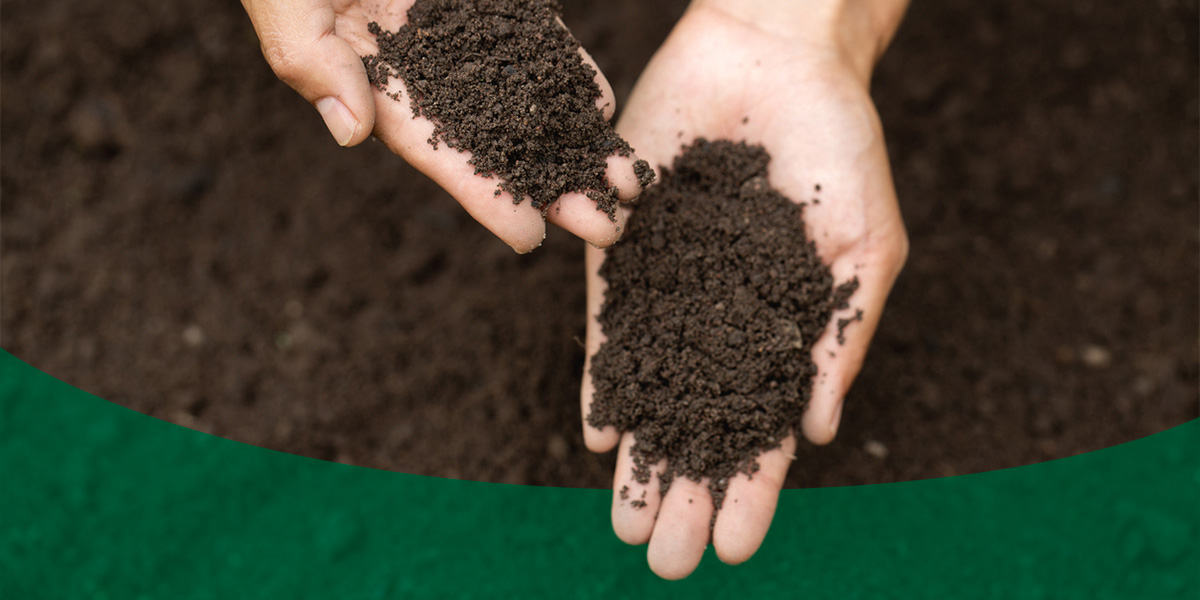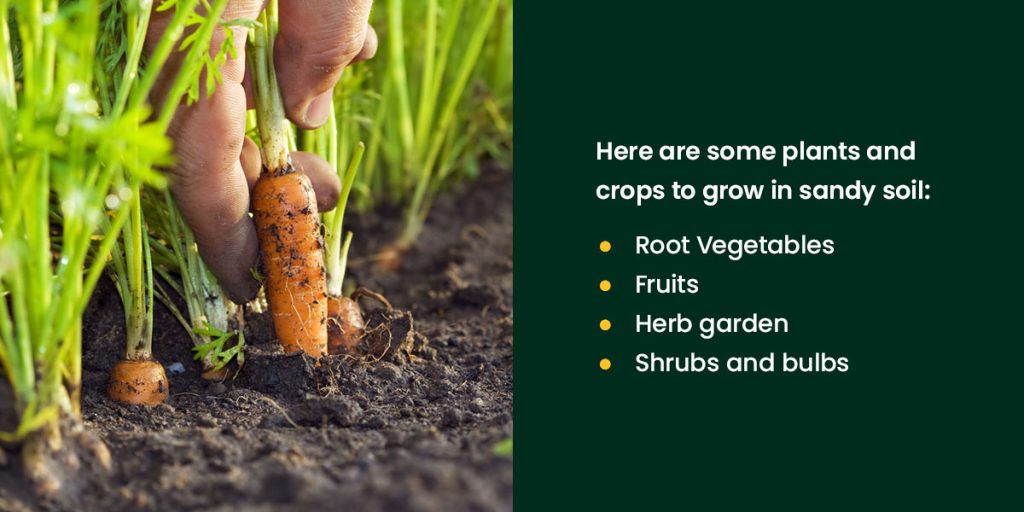Are you struggling to find the perfect crop for your sandy soil? You’re not alone.
Many gardeners and farmers face the same challenge, wondering which plants will thrive in such conditions. Sandy soil can be tricky. It drains quickly, leaving your plants thirsty, yet it also provides opportunities for certain crops to flourish where others might fail.
Imagine transforming your patch of land into a thriving oasis by simply choosing the right crops. This could mean healthier plants, bigger yields, and less work for you. You’ll discover which crops are best suited for sandy soil, helping you to maximize growth and minimize effort. Let’s dive into the details to help you make the most of your land.

Characteristics Of Sandy Soil
Understanding the characteristics of sandy soil is crucial for successful gardening or farming. Sandy soil, with its unique texture and properties, poses certain challenges but also offers specific advantages. Knowing these traits can guide you in selecting the right crops to thrive in such conditions.
Texture And Drainage
Sandy soil is known for its gritty texture, which results from its high sand content. This texture allows water to drain quickly, preventing waterlogging. However, it also means nutrients can leach away faster, requiring you to fertilize more often.
Imagine walking along a beach; the sand shifts beneath your feet, and water doesn’t pool for long. That’s how sandy soil behaves in your garden. While quick drainage prevents root rot, you need to be diligent with watering.
Low Nutrient Retention
One challenge with sandy soil is its low ability to hold nutrients. Essential minerals can wash away with rain, leaving your plants hungry. To counter this, use organic matter like compost to improve nutrient retention.
Think of sandy soil as a sieve, letting nutrients slip through. Regular amendments with compost create a buffer, holding nutrients longer for your plants to use.
Warmth Absorption
Sandy soil warms up quickly in the sun, promoting faster plant growth in the early season. This characteristic is perfect for crops that prefer warm roots, like tomatoes or peppers.
Have you noticed how quickly the beach sand heats up under the sun? This warmth absorption is ideal for jumpstarting growth in crops that thrive in warm conditions.
Ease Of Tilling
Tilling sandy soil is relatively easy due to its loose structure. This makes preparation for planting less labor-intensive compared to other soil types.
If you’ve ever tried digging a hole at the beach, you know how effortlessly sand yields to your spade. This ease of tilling lets you prepare your garden beds with minimal effort.
What crops have you successfully grown in sandy soil? Share your experiences and insights in the comments below. Embrace the unique characteristics of sandy soil, and your garden can flourish with the right choices!

Ideal Crops For Sandy Soil
Sandy soil benefits crops like carrots, peanuts, and strawberries. These plants thrive in well-drained conditions. Selecting the right crop ensures better growth and yield.
When you think of sandy soil, you might imagine a barren landscape, but it’s far from useless. With the right crops, sandy soil can be highly productive. Its quick-draining nature is both a challenge and an advantage. Let’s explore some ideal crops that thrive in sandy conditions and can turn your patch of earth into a thriving oasis.Carrots
Carrots love sandy soil. The loose texture allows their roots to grow deep and straight. If you’ve ever struggled with misshapen carrots, sandy soil might be your solution. Plus, they mature quickly, making them a rewarding choice for impatient gardeners.Potatoes
Potatoes thrive in sandy soil due to its excellent drainage. This reduces the risk of waterlogged roots, which can lead to disease. If you’re aiming for a bumper crop, consider adding some organic matter to boost nutrients. Have you ever tasted a freshly dug potato? The flavor is incomparable.Radishes
Radishes are quick-growing and perfect for sandy soil. Their fast maturation means you can enjoy them just a few weeks after planting. They also act as a great cover crop, protecting your soil in between larger plantings. Plus, they add a spicy kick to your salads!Watermelons
Watermelons, with their sprawling vines and juicy fruit, adore sandy soil. The warmth that sandy soil provides is perfect for their growth. Consider using black plastic mulch to retain moisture and heat. Imagine the delight of slicing into a home-grown watermelon on a hot summer day.Peppers
Peppers, both sweet and hot, prefer the warmth of sandy soil. It heats up quickly, giving peppers the boost they need. Add some compost to improve moisture retention and watch your pepper plants flourish. Have you tried growing peppers before? They can add vibrant colors to your garden.Asparagus
Asparagus is a perennial that relishes sandy soil. It requires well-drained conditions, making sandy patches ideal. Plant it once and enjoy a harvest for years. Investing in asparagus can be a long-term win for your garden. By choosing the right crops, you can make the most of sandy soil. Which of these crops will you try in your garden next season?Enhancing Sandy Soil Fertility
Selecting crops like millet, barley, or potatoes can improve sandy soil fertility. These crops adapt well and enhance soil structure. Their growth adds organic matter, boosting nutrient content.
Enhancing sandy soil fertility can be a game-changer for your garden or farm. Sandy soil has its perks—it’s well-drained and easy to work with. But it often lacks the nutrients plants need to thrive. Let’s dive into practical ways to boost its fertility so you can choose the right crops for your sandy soil.Understanding Sandy Soil
Sandy soil is composed of larger particles, which means it drains quickly. This quick drainage can lead to nutrient loss. Have you noticed your plants looking a bit sad after a rainstorm? That’s because sandy soil doesn’t hold onto nutrients well. It’s crucial to understand its properties before enhancing its fertility.Adding Organic Matter
Organic matter is your sandy soil’s best friend. Adding compost or well-rotted manure can significantly improve its nutrient content. Picture this: a lush garden bed brimming with vibrant vegetables. That’s the power of organic matter at work.Using Cover Crops
Cover crops, such as clover or rye, are excellent for sandy soil. These crops help add nutrients back into the soil when they decompose. Plus, they prevent erosion. Have you tried planting cover crops in the off-season? They can dramatically improve soil health.Applying Fertilizers Wisely
Fertilizers can be beneficial, but it’s all about timing. Applying them just before a rainstorm might wash them away. Consider slow-release fertilizers that provide nutrients over time. Have you ever thought about how the timing of your gardening tasks impacts your crop yield?Testing Soil Regularly
Testing your soil lets you know what nutrients are missing. You wouldn’t head out on a road trip without checking your car’s fuel levels, right? The same goes for soil testing—it’s essential for planning your gardening journey.Mulching Techniques
Mulch is more than just a pretty cover for your garden beds. It helps retain moisture and adds nutrients as it breaks down. Have you walked through a garden and noticed how fresh everything looks? Mulch keeps sandy soil healthy and vibrant. These strategies can transform your sandy soil into a fertile haven for crops. Experiment with them, and watch how your garden evolves. What’s your next step in enhancing your sandy soil’s fertility?
Expert Tips For Crop Selection
Choosing the right crop for sandy soil can be tricky. Sandy soil drains quickly and lacks nutrients. But, with the right choice, you can still have a successful harvest. Here are expert tips to help you select the best crops for sandy soil.
Understand Your Soil’s Characteristics
First, know your soil’s pH and nutrient levels. Sandy soil often lacks organic matter. Test your soil to identify its needs. This knowledge helps in choosing compatible crops.
Opt For Drought-tolerant Crops
Sandy soil drains water quickly, so pick drought-tolerant crops. These crops thrive in dry conditions. Carrots, peanuts, and potatoes are good options. They require less water and adapt well.
Choose Deep-rooted Plants
Deep-rooted plants are ideal for sandy soil. They reach deeper moisture layers. This helps them survive dry spells. Tomatoes and alfalfa have deep roots, making them suitable choices.
Consider Crops With Short Growing Seasons
Short growing season crops mature fast. This is beneficial in sandy soil. Radishes and lettuce grow quickly. They are ready for harvest in a short time.
Incorporate Organic Matter Regularly
Regularly add compost to your soil. This improves nutrient content and water retention. It makes sandy soil more fertile. Healthy soil leads to better crop yields.
Seek Local Agricultural Advice
Consult local experts for tailored advice. They have experience with local soil conditions. Their insights can guide your crop selection process effectively.
Conclusion
Choosing crops for sandy soil doesn’t have to be tricky. Focus on hardy plants that thrive in these conditions. Consider root vegetables like carrots and radishes. They grow well in sandy soil. Succulents, such as aloe, also do great. Remember, water drains quickly in sandy soil.
Regular watering is essential. Mulching helps retain moisture. Test soil pH to ensure optimal growth. With the right choices, your garden will flourish. Sandy soil offers unique gardening opportunities. Embrace them and enjoy your thriving garden. Happy planting!

